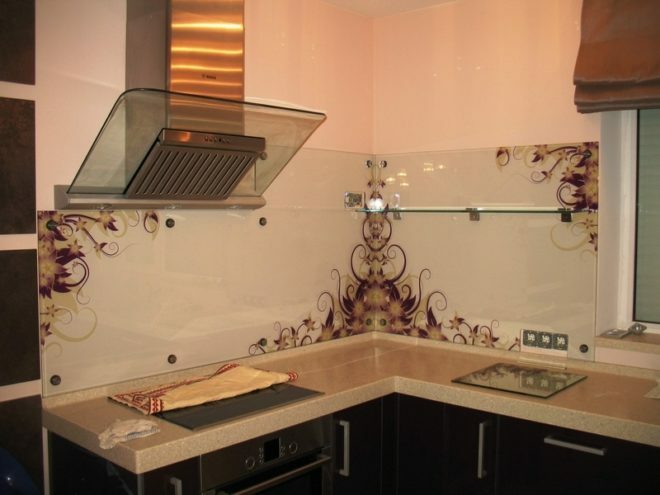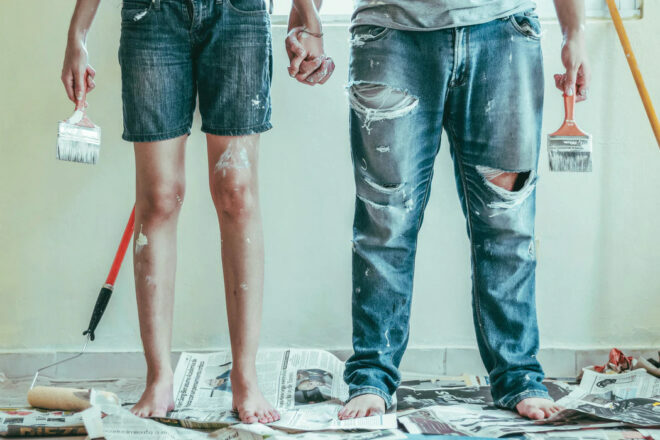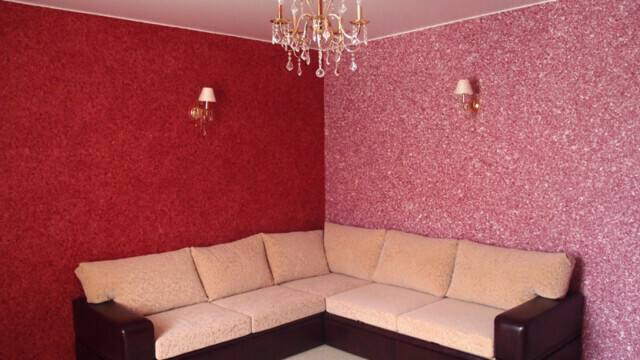Recently, people have become much more careful about the issue of repairs. Smooth walls are a prerequisite, without which repairs cannot be carried out efficiently. Even in new aerated concrete buildings, the walls are not entirely even, not to mention the old Khrushchev buildings, therefore, repairs before finishing the walls are necessary. In order not to overpay the masters, many people decide to do the alignment of the walls with their own hands.
What you need to level the walls and how to do it is described in this article.

Attention! Earned on our website kitchen designer. You can get acquainted with it and design your dream kitchen for free! May also come in handy wardrobes designer.
Wall alignment methods
Ways to align walls in an apartment or house:
- wet, provides for the use of several mixtures;
- dry, arrangement with plasterboard structures.
Wet leveling with plaster. This method is used when there are small defects (differences of no more than 50 mm) of small-area walls. If desired, the wall can be adjusted in a large area with strong drops. However, this will entail large financial and time costs. A big plus of wet leveling is that the area of the room does not decrease in the least. The disadvantage is the formation of a large amount of dirt and dust during work. Although this may not interfere, if you are already doing major repairs - laying tiles, installing partitions, dismantling doorways, etc.
Dry leveling with plasterboard. Unlike the previous method, this one allows you to eliminate large surface irregularities. The main advantage is the ability not to prepare the wall before installing the plasterboard frame and sheathing sheets. It is desirable that there are no crumbling areas. The sub-structure compartments can be filled with soundproofing or thermal insulation materials. It is also easy to hide various kinds of communications here. Together with smooth walls, we get a slightly reduced space. On sale you can find 2 types of drywall: plain gray and moisture resistant green.
Further in the article will provide step-by-step instructions on how to align the walls with your own hands.
Plastering walls
The first step is to prepare the surface. Here is the sequence of actions:
- We remove the old finish, especially the one that does not hold well.
- All cracks in the wall are widened, after which the degree of unevenness is assessed. Further, large and prominent indents are removed with a hammer and other suitable tools.
- If there is old plaster on the wall, you need to assess its condition. To do this, knock on it, if a dull sound is heard, then there are voids there, which will inevitably lead to a collapse during alignment.
- All large valleys are adjusted separately. An overly thick layer is capable of chipping off, so small defects are sealed with mortar, and large protrusions simply go astray.
- If you are going to finish the walls with paint, then without a special coating it will come off in pieces. To avoid this, apply a primer - concrete contact. It will roughen the surface. In this case, the putty will "hold" the paint well and nothing will fall off.
- For even more tenacious bonding of materials, notches are used (100 pieces per 1m2). Previously, an ax was used for this, now - a grinder.
The primer can be either ready-made or requiring dilution. In any case, it is necessary.
Installation of guide rails-beacons
To get a flat surface from a curved wall, use beacons specially designed for this. This is a profile that is installed parallel to the wall, and the beacon will perform the function of directing the plaster to empty spaces, removing voids. Basically, a T-shaped profile is chosen from zinc coated steel, but some use bars as guides.
Mounting a metal lighthouse is easier and more convenient than a bar. The plaster layer will be approx. 7 mm. The disadvantage of this method is additional financial costs. Although the amount is small. Plaster adheres terribly to metal, so after drying is complete, the beacon slats are pulled out and the holes are closed.
Wooden slats, although they have a lower cost, are more difficult to pick up a bar. The wood warps from moisture, and the layer is not even. Some people use a special mixture instead of standard beacons. First, plaster strips are applied to the wall, and leveled. When they dry, they are already used as beacons. The most economical method, but also the most time consuming.
Installation is carried out in this way: several lumps of plaster are thrown onto the wall. A bar or profile is applied to them. Levels below the level, you can use a plumb line. After the cakes have solidified, work is continued. Orient the distance m / d beacons according to the rule (must be available).
We start plastering
The solution is prepared according to the manufacturer's instructions and then thrown onto the wall. From the tools, you will need a spatula or molar ladle. After the composition is applied to the wall, your next steps are as follows:
- You should start the sketch from the bottom point between the beacons, covering part of the wall.
- The rule is set at the lowest point of the beacons. The plaster moves upwards, resting on them. The mixture is applied with light swinging movements of the rule to the sides.
- Plastering is necessary until the solution is as smooth as possible.
- With a spatula, remove the stuck mixture and throw it on the wall.
- We carry out this work to the very ceiling. Having finished laying out one strip of beacons, we proceed to laying the next one. Do this with every square meter until the surface of the entire wall is leveled.
The initial part of the work is over, but it still has to be aligned. Because visual defects are still noticeable. The liquid composition of the putty will finally help to complete, but we will talk about this later.
Plasterboard wall alignment
This option is a good alternative to working with plaster, because it is faster and more practical. The result also wins - the walls are as flat as possible. With this technology, repairs can be completed earlier than tinkering with plaster. At the exit, we will get a rough finish of the room. In the process, you can decorate it with any decorative elements, leave the wall for painting or glue the wallpaper. We will analyze all the stages of how to level a concrete wall, brick using drywall.
Making the markup
Like the wet leveling method, dry leveling also starts with marking, but now under the frame. It consists of several horizontal profiles at different locations. The markup is very important, as it determines the position of the future drywall wall. The following is the sequence of its execution.
First, on the ceiling we draw a line of the wall (which will be in the future) using a paint cord or a long level. We mark the exact same on the floor directly below it. A plumb line (any weighty object on a string) will help to do this: mark 2 points on the floor, connect, mark a line.
Secondly, we make markings on the walls with a paint cord.
That's all, it will not be difficult to do this. The main thing to consider is 2 important parameters:
- the gap between the wall and the frame should be sufficient for carrying out communications or laying, but should not be very large, so as not to greatly narrow the room;
- it is necessary to achieve visual alignment of the walls. What it is? The angle between the walls and the floor, the ceiling is 90 degrees, that is, all connections should be almost perfect.
To check how perfect the corners of the room are, measure the diagonals. If they are equal, then everything is fine.
We mount the profile
The frame for Mr. is made of metal profiles. Most often, preference is given to the ceiling profile and the guide profile. They are also used to make the ceiling frame. The advantage of these types of profiles is the insignificant loss of room area due to their geometric parameters.
Installation begins with the assembly of PN. For convenience, it is installed first on the ceiling and then on the walls, adhering to the markings. Attached with dowel nails in increments of 50 to 60 cm.
Next, we carry out the markup for the uprights. They are installed in increments of ~ 60 cm. To make the wall more rigid, this value can be reduced to 40 cm. M / d uprights, the distance should be a multiple of the width of the drywall sheet.
The next step is to fix our suspensions with a step of about 55 cm. This will add rigidity to the structure.
We pass to the PP. We cut it to the required length and insert it into the NP cavity. After that, we install the vertical stand according to our markings and fix it to the direct suspensions using self-tapping screws.
In places where it is planned to mount heavy objects (TV, etc.) into the wall, install a fixing or additional stands.
Plasterboard laying on the frame
In most cases, use Mr 11mm thick. For dry places such as a living room, bedroom or hallway, you can safely use a regular Mr. gray. If you are repairing the walls in a room with high humidity (for example, in the kitchen), then the moisture-resistant green Mr. is simply irreplaceable.
For high ceilings (over 2.5 m), GKL acquires ~ 3 m.
Sheets are cut to the desired size, applied to the finished frame and fixed with self-tapping screws. The fixation step in this case is 15-20 cm. To make it easier to work, you can draw profile lines on the gypsum board. This will help pin Mr. exactly to the desired profile.
When working with a sheet, watch the head of the self-tapping screw. She must completely "trample" into it. However, throwing the cardboard onto the surface is undesirable.
Finishing - wall putty
Now you know everything about how to straighten the walls in an apartment. It remains to find out about the final stage of this process. Plastered walls will help to make the surface as smooth as possible. It is advisable to tackle it immediately after leveling with plaster or drywall. There are 3 main types of mixture for finishing putty. Before you buy, choose the right one based on the stated characteristics:
- Cement. It has good moisture resistance and a reasonable price. Cracks appear over time.
- Plaster. Smooth surface, no shrinkage. Can be applied in thick layers, dries quickly. Not resistant to water.
- Polymeric. It adheres well, long-playing solution. Smoothness after the first application. High price. Work comfortably in normal humidity.
Putty tools and some features of this work
Below is a complete list of tools and supplies you may need.
- spatula up to 50 cm wide;
- spatula up to 17 cm wide;
- putty;
- a rectangular vessel for the mixture;
- cloth, sponge;
- spray bottle with water;
- respirator;
- a source of good lighting;
- pumice, sandpaper;
- drill;
- wide tassel.
The finishing putty differs from the starting one in that the consistency of the mortar first must be more viscous and dense.
If you need a thick layer of putty, apply it in stages to avoid swelling and flaking.
After installation, you can paint the walls with varnish or oil paint.
In the final stages, use a respirator so as not to damage the mucous membranes of the eyes or respiratory tract with dust.
Putty application technology
- We fall asleep 5-7 kg of dry matter and gradually add water, constantly stirring the solution. The consistency should come out creamy.
- With a small spatula we select a little composition and transfer it to a wide spatula. Apply with smooth diagonal movements (this will make it smoother). The second time we try to distribute it evenly.
- We approach from the other side and do the same work.
- Usually, 2 layers of putty are required on the wall. Approximately 12 hours should elapse between the first and second application. During this time, the mixture will dry out. But don't let it dry completely, as it will be much more difficult to apply.
- The maximum layer in the corners is 5 mm, in the middle - 1-2 mm.
Now you have the knowledge on how to properly align the walls in an apartment. To have a more complete understanding of this process, we recommend that you familiarize yourself with the photos and videos on this topic.


